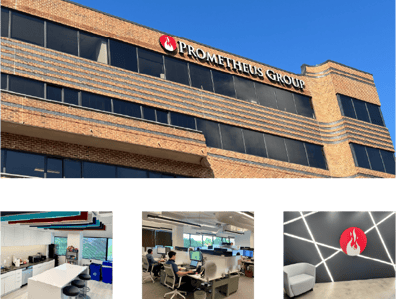What is Enterprise Asset Management?
If you have already been managing your company’s assets for years, you probably have a good idea of what enterprise asset management is.
If you are new to asset management or you’ve never formally learned the concept of asset management, you may be trying to understand what it all means.
With so many definitions, especially purely investment and financially focused definitions, we thought we would define enterprise asset management for the maintenance and asset management folks out there.
In this article, we will cover the definition of what enterprise asset management (EAM) is, what is involved in it, the industries that need it and how to evaluate your current EAM processes.
Definition of EAM(Enterprise Asset Management)
The field of enterprise asset management is focused on managing the assets of your business. This includes asset purchasing, maintaining, repairing, tracking, retiring, replacing, and all other functions of managing the asset life cycle.
Asset management is crucial for sustaining a company’s profit-generating capital. Savings made on an organization’s largest ticket items make significant impacts on the bottom line. Tracking the health of your assets makes it possible to identify and address issues with your equipment before they fail.
For critical assets and hard to find parts, planning your maintenance windows ahead of time results in huge savings from lost production and expedited component deliveries.
All businesses, especially asset-intensive businesses, know that it is important to maintain their assets. However, not all businesses start with solid asset management. It is usually after large spurts of growth that they begin to recognize the need for it.
For more established organizations, robust maintenance practices may have degraded with time and personnel change. These businesses may also recognize the need to revitalize their maintenance processes.
Why is EAM Important?
Enterprise Asset Management is essential because it directly impacts the operational efficiency, safety, and profitability of an organization. EAM ensures that critical assets are maintained and optimized for performance throughout their lifecycle. Without effective asset management, businesses risk unplanned downtime, costly repairs, and compliance issues.
Moreover, a solid EAM strategy enables better resource allocation, minimizes waste, and fosters sustainability by prolonging asset life. As industries become more reliant on complex machinery and technology, having an EAM system in place becomes a competitive necessity.
Benefits of Prometheus EAM Software
Prometheus EAM software is designed to bridge the gap between asset-intensive industries and the challenges they face in maintenance, compliance, and data integrity.
Key benefits include:
- Improved Maintenance Efficiency: Streamline work orders, optimize scheduling, and reduce unplanned downtime with intuitive tools tailored to your needs.
- Enhanced Data Accuracy: Centralize asset data and ensure alignment between physical and digital assets for informed decision-making.
- Regulatory Compliance: Stay audit-ready with automated tracking and reporting of compliance metrics.
- Cost Savings: Optimize asset performance and reduce costs by preventing equipment failures and extending asset lifecycles.
- Seamless Integration: Prometheus software integrates effortlessly with leading EAM platforms, providing enhanced functionality without disrupting existing workflows.
SaaS EAM
Software-as-a-Service (SaaS) EAM solutions provide cloud-based platforms that eliminate the need for on-premises infrastructure.
Key advantages include:
- Scalability: Easily adapt to the needs of growing businesses without extensive hardware investments.
- Real-Time Access: Cloud accessibility allows users to access asset data and maintenance systems anytime, anywhere.
- Reduced IT Costs: SaaS eliminates the need for extensive IT management, reducing overhead while ensuring the system stays up-to-date.
- Enhanced Collaboration: Teams across geographies can collaborate seamlessly, sharing updates and real-time data.
- Improved Security: SaaS EAM providers implement high-level security protocols to protect sensitive business data.
How is an EAM system deployed?
An EAM system can be deployed in several ways, depending on the organization’s size, industry, and existing infrastructure:
- On-Premises: Installed locally on company servers, this approach offers control but requires significant IT resources.
- Cloud-Based (SaaS): A popular choice for its scalability, real-time access, and minimal infrastructure demands.
- Hybrid Deployment: Combines on-premises control with cloud flexibility to meet specific organizational needs.
How does EAM integrate with existing systems?
Integration is a cornerstone of effective EAM implementation. EAM systems can connect with other enterprise software, such as:
- ERP Systems: Synchronize asset management with financial, procurement, and supply chain processes.
- CMMS: Enhance maintenance planning and scheduling by bridging gaps between asset lifecycle management and operational maintenance.
- IoT Devices: Incorporate real-time monitoring and predictive maintenance capabilities for connected equipment.
Key Features of Enterprise Asset Management
Under the enterprise asset management umbrella, the following activities make up the asset management process:
Maintenance Planning and Scheduling
Maintenance planning answers what tasks are being done and scheduling answers when a task is being done. Efficient planning and scheduling of maintenance activities allows your organization to proactively manage its assets and reduce the time and energy needed to “fight fires.”
Inventory Management
Having a solid inventory management system allows you to ensure your maintenance teams have the right part, for the right job, at the right time. Good inventory tracking also entails accurate records of materials coming in and out of your warehouse or stock room so you can make better purchasing decisions when it comes time to restock.
Environmental Health and Safety
Completion of work in a safe manner is paramount to every industry. Costs incurred due to lost time to injury, damaged reputation, and higher insurance premiums are entirely avoidable. A key component to enforcing a proper risk management strategy involves creating, tracking, and storing permits not only to ensure tasks are being completed in a safe fashion but also so that these records can be easily accessed for auditory compliance.
Many organizations have adopted Electronic Permit Administration Systems (ePAS) in order to digitalize this process.
Master Data Management
At the heart of any maintenance program is master data. Ensuring that you have accurate and complete asset master data can have a direct impact on reducing environmental, health and safety risks; improving operations performance; and maintaining regulatory compliance.
Master data management ensures your system is created to have “digital twins,” so that your digital assets reflect your physical assets. This allows you to trust that what is recorded in your maintenance system is really out in your plant.
Shutdowns, Turnarounds, and Outages (STO)
Maintaining critical assets necessitates bringing individual equipment, process units, or even entire facilities offline for brief or extended periods of time to perform maintenance you cannot perform during runtime. This inherently conflicts with the operational/productive capacity of impacted assets, leading to losses of output and revenue.
Accurate and efficient planning of shutdown, turnaround, or outage (STO) events is therefore crucial for any organization to minimize costs during the event and sidestep possible failures in the future as a result of deferred maintenance.
Project and Portfolio Management
As an organization develops, expansion of facilities and green field projects require a considerable amount of financial risk. A strong project methodology centered around accurate record keeping is key to validating contractual obligations, technical integrity, and safety.
This is in conjunction with a push for critical path and milestone adherence leads to successful project completion and safeguards those investments.
Contractor Management
External resources are often needed for a company to perform specialized tasks during STO or capital project events, or on an ongoing basis where internal resources are more effectively deployed in other areas. Managing these long-term embedded contractors to track time, attendance, fatigue, and cost in a consistent and accountable process ensures accurate payment is made on time.
Mobile Maintenance Management
With increasing intensity, organizations are recognizing the benefits of empowering maintenance teams with mobile solutions. Mobile maintenance management from the field leads to a dramatic reduction of time wasted in travel, double data entry, and cumbersome paper-based processes. Mobility enhancements therefore play a key role in the larger digitalization efforts seen across most industries.
Software Systems Used to Manage Enterprise Assets
Depending on business size, business type, and business enterprise asset management needs, companies will use different kinds of systems to manage the asset management functions listed above. For instance, you could use a:
ERP (Enterprise Resource Planning) System
What is an ERP?
An ERP system is set up to help you run all of your business functions from accounting, supply chain management, asset management, inventory management, production, procurement, and much more.
EAM (Enterprise Asset Management) System
What is an EAM?
An EAM’s sole purpose is to help you manage your assets throughout their entire lifecycle. It is designed to help you maximize your asset’s use from the moment you purchase it to when you retire the machine.
What is SAP EAM?
SAP EAM is a leading enterprise asset management software solution designed to help organizations manage their asset lifecycle efficiently. It enables businesses to plan, schedule, and execute maintenance activities while ensuring compliance with industry standards. Key features include asset performance tracking, predictive maintenance, and integration with SAP’s ERP ecosystem. SAP EAM is particularly beneficial for large, asset-intensive industries seeking comprehensive and scalable solutions.
CMMS (Computerized Maintenance Management System)
What is CMMS?
A CMMS is designed to help you manage all aspects of your maintenance. It holds maintenance information, helps you track worker availability, schedule maintenance, review work orders, manage inventory, run reports, and more.
Depending on the factors listed above, you will need different types of systems to manage maintenance and business processes. For the purpose of this article, we will be focusing on EAMs.
Differences Between EAM, ERP, and CMMS
What is the difference between EAM and ERP?
The main distinction lies in focus. ERP systems manage all business processes, from finance to HR to supply chain, while EAM systems specialize in the lifecycle management of physical assets. EAM is often a module within an ERP but offers deeper functionality for asset-intensive industries.
What is the differences between CMMS and EAM?
CMMS focuses on managing day-to-day maintenance tasks, such as work orders and preventive maintenance schedules. In contrast, EAM takes a broader approach, covering the entire asset lifecycle, including procurement, usage, and retirement, and integrates with other enterprise systems for strategic asset optimization.
Industry Applications and Use Cases that Benefit from Enterprise Asset Management
Enterprise asset management was designed for businesses with expensive and complex assets that require regular monitoring and maintenance.
Industries that benefit from asset management include:
- Oil and Gas
- Mining and Metals
- Utilities and Power Generation
- Chemicals and Petrochemicals
- Public Sector, Municipalities, and Transportation
- Pharmaceuticals and Life Science
- Food and Beverage
- Pulp and Paper
- Forestry
- Manufacturing
- Healthcare
- Education
- Entertainment
- Automotive
- Military and Defense
- Retail and Fashion
As companies in these industries build out their EAM processes and begin utilizing software to streamline them, they notice higher levels of efficiency in their operations and production.
Does Your Current EAM System Meet the Needs of Your Organization?
As a maintenance professional, your current EAM system may be the only one you’ve worked with or you may have become familiar with several over the course of your career. Often times, unique processes inherited by your facility require workarounds or a series of workarounds to accomplish day-to-day operations or record keeping.
Other times critical tasks are performed in separate unconnected systems creating silos of data. Understanding how your maintenance team is interacting with an EAM system is paramount in determining if your business needs are being met.
Ask yourself the following questions about your EAM system and your maintenance processes:
- Is your team planning outside of your EAM, in spreadsheets, or a separate system?
- Is information reported and recorded verbally or on paper before being entered into a system by another individual?
- Is there a significant amount of time wasted making unnecessary trips back and forth between the field and the office?
- Does your team often find themselves “fighting” with the system trying to find information they know is there?
- Are metrics and KPIs generated and updated manually? How much time is spent a week creating analytical reports?
- Do you have difficulty finding records efficiently for auditing or compliance reasons?
- Are internal or external compliance metrics being met consistently?
- Does your EAM system accurately reflect your true backlog? Is there a lag of more than a week between work completion and records being updated in the system?
- Are contractor timesheets validated quickly and accurately? How much time is spent verifying contractor time and attendance?
- Are major maintenance events such as shutdowns, turnarounds, and outages (STOs) running over schedule or over budget?
- Does your organization have a master data governance strategy?
Depending on your answer to any of these questions, your organization may not be utilizing your EAM system as effectively as it could be.
Due to a wide range of different needs across the industry, EAM software solutions do not always provide all of the functionality needed for maintenance users. This leads to workarounds, manual processes, and a general lack of usability.
This is where maintenance-focused solutions that integrate directly with your EAM system provide benefits. Improved functionality, user interface, and user experience (while still maintaining data integrity within the core system) allows organizations to drastically improve user adoption and efficiency with existing EAM software.
Start Managing Your Enterprise Asset Management Efficiently With Prometheus Group Software
Reaching world class maintenance standards is the goal for organizations large and small across every industry. Ensuring your teams are using the right software to manage their maintenance process is paramount to the smooth operation of the organization as a whole.
Proper asset management will save your organization money through time savings, increased production, reduced errors, and more efficient maintenance processes.
To learn how the Prometheus Platform can help you improve your maintenance and reduce costs, contact us today.



